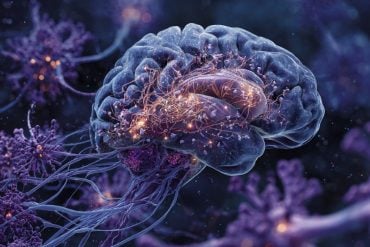Summary: Alzheimer’s disease is traditionally seen as a brain disorder, but new research using fruit flies reveals that it also affects organs and tissues throughout the body. Scientists created an Alzheimer’s Disease Fly Cell Atlas to profile gene expression across 219 cell types in flies expressing human Alzheimer’s proteins.
They found that Aβ42 mainly damages neurons, particularly those tied to senses like smell, while Tau impacts peripheral tissues, disrupting metabolism, digestion, and fertility. These findings highlight how Alzheimer’s disrupts brain-body communication and accelerates aging-like changes.
Key Facts:
- Whole-Body Impact: Aβ42 and Tau proteins affect both brain and peripheral tissues.
- Distinct Effects: Aβ42 harms sensory neurons, while Tau disrupts metabolism and fertility.
- New Research Tool: The Fly Cell Atlas enables exploration of Alzheimer’s beyond the brain.
Source: Baylor College of Medicine
While Alzheimer’s disease is mostly considered a disorder of the brain, emerging evidence suggests that the condition also affects other organs of the body.
Working with the laboratory fruit fly, researchers at Baylor College of Medicine, the Jan and Dan Duncan Neurological Research Institute at Texas Children’s Hospital (Duncan NRI) and collaborating institutions provide a new understanding of how Alzheimer’s disease affects different tissues across the entire body.

The findings, published in Neuron, reveal new insights into brain-body communication in neurodegeneration and pave the way for identifying novel biomarkers and therapeutic targets for Alzheimer’s disease.
“Alzheimer’s disease is a neurodegenerative disorder characterized by the accumulation in the brain of amyloid plaques containing the Aβ42 protein and tangles of thread-like structures of the Tau protein.
“To better understand how the disorder affects other organs in the body, we created an Alzheimer’s Disease Fly Cell Atlas, which profiles the genes expressed by single cells of 219 cell types in the heads and bodies of Alzheimer’s disease fruit flies,” said co-corresponding author Dr. Hongjie Li, assistant professor of molecular and human genetics and the Huffington Center on Aging at Baylor.
He is also a member of Baylor’s Dan L Duncan Comprehensive Cancer Center.
The researchers created Alzheimer’s disease fruit flies by expressing Aβ42 or Tau only in the neurons of adult flies. This approach avoids developmental effects and focuses on adult characteristics. Then, they assessed the presence of changes in the brains and other organs of these modified flies.
“We found that expressing Aβ42 or Tau in neurons affected both neurons and other tissues in the fruit fly body,” said co-first author Ye-Jin Park, a graduate student co-mentored by Li and Dr. Hugo Bellen.
“Aβ42 expression primarily affected the nervous system. Sensory neurons involved in vision, audition and olfaction were particularly vulnerable. A decline in the sense of smell can be an early symptom of Alzheimer’s disease, and in this study we identified specific olfactory neurons affected by Aβ42 in fruit flies.”
“On the other hand, Tau expression in neurons led to significant changes, mostly in peripheral tissues, for instance altered fat metabolism and digestion and reduced fecundity. These alterations mimic age-associated changes, suggesting that Tau expression accelerates aging,” said co-first author Dr. Tzu-Chiao Lu, a postdoctoral associate in the Li lab.
“We found that neuronal connectivity and other factors that mediate brain-body communication were disrupted in Tau flies.”
“These and other findings described in the Alzheimer’s Disease Fly Cell Atlas improve our understanding of how Alzheimer’s disease-associated proteins, Aβ42 and Tau, affect an organism as a whole,” said Bellen, co-corresponding author of the work. Bellen is a Distinguished Service Professor of Molecular and Human Genetics at Baylor and chair in neurogenetics in the Duncan NRI.
This comprehensive resource serves as a valuable tool for the neurodegeneration research community. The Alzheimer’s Disease Fly Cell Atlas enables further exploration of whole-body changes and brain-body interactions in Alzheimer’s disease that may lead to a better understanding of the condition and improved treatments.
Other contributors to this work include Tyler Jackson, Lindsey goodman, Lindsey Ran, Jiaye Chen, Chung-Yi Liang, Erin Harrison, Christina Ko, Xi Chen, Baiping Wang, Ao-Lin Hsu, Elizabeth Ochoa, Kevin F. Bieniek, Shinya Yamamoto, Yi Zhu, Hui Zheng and Yanyan Qi. The authors are affiliated with one or more of the following institutions: Baylor College of Medicine, Jan and Dan neurological Research Institute at Texas Children’s Hospital, National Yang Ming Chiao Tung University – Taiwan, University of Michigan and U.T. Health San Antonio.
Funding: This study was supported by grants from NIH/NIA R01-AG073260, OD R24-OD02205, OD R24-OD031447, NIH/NIGMS R01-GM067858, NIH/NIA U01-AG072439, the Huffington Foundation, the endowment of the Chair of the Neurological Research Institute, a CPRIT Scholarship in Cancer Research (RR200063) and NIH/NIA U01-AG086143.
About this Alzheimer’s disease research news
Author: Homa Warren
Source: Baylor College of Medicine
Contact: Homa Warren – Baylor College of Medicine
Image: The image is credited to Neuroscience News
Original Research: Open access.
“Distinct systemic impacts of Aβ42 and Tau revealed by whole-organism snRNA-seq” by Hongjie Li et al. Neuron
Abstract
Distinct systemic impacts of Aβ42 and Tau revealed by whole-organism snRNA-seq
Both neuronal and peripheral tissues become disrupted in Alzheimer’s disease (AD). However, a comprehensive understanding of how AD impacts different tissues across the whole organism is lacking.
Using Drosophila, we generated an AD Fly Cell Atlas (AD-FCA) based on whole-organism single-nucleus transcriptomes of 219 cell types from flies expressing AD-associated proteins, either human amyloid-β 42 peptide (Aβ42) or Tau, in neurons.
We found that Aβ42 primarily affects the nervous system, including sensory neurons, while Tau induces accelerated aging in peripheral tissues. We identified a neuronal cluster enriched in Aβ42 flies, which has high lactate dehydrogenase (LDH) expression.
This LDH-high cluster is conserved in 5XFAD mouse and human AD datasets. We found a conserved defect in fat metabolism from both fly and mouse tauopathy models.
The AD-FCA offers new insights into how Aβ42 or Tau systemically and differentially affects a whole organism and provides a valuable resource for understanding brain-body communication in neurodegeneration.







